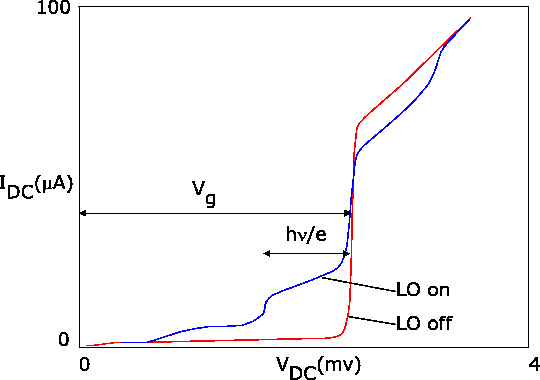Two kinds of charged particles can exist in a superconductor:
a) ordinary electrons; b) so-called Cooper pairs, consisting of two
electrons interacting and weakly bound together by the exchange of
phonons (lattice vibrations); breaking a Cooper pair costs an energy
![]() . Correspondingly, two kinds of currents can
flow across the junction: the Josephson current, consisting of Cooper
pairs, and the so-called quasi-particle current, consisting of
``ordinary'' electrons (presumably ``electron'' did not sound fancy
enough). To keep this digression into SIS physics short, let's just
state that the Josephson current can be ignored. At the operating
temperature of the mixer, and in an unbiased junction, the population of
quasi-particles is virtually negligible. But, if the bias voltage is
raised to the gap voltage
. Correspondingly, two kinds of currents can
flow across the junction: the Josephson current, consisting of Cooper
pairs, and the so-called quasi-particle current, consisting of
``ordinary'' electrons (presumably ``electron'' did not sound fancy
enough). To keep this digression into SIS physics short, let's just
state that the Josephson current can be ignored. At the operating
temperature of the mixer, and in an unbiased junction, the population of
quasi-particles is virtually negligible. But, if the bias voltage is
raised to the gap voltage
 |
In the presence of electromagnetic radiation, the situation is
modified as follows. If a RF photon is absorbed, its energy ![]() can contribute to the energetic budget, which can now be written
as:
can contribute to the energetic budget, which can now be written
as:
So far I've shown you qualitatively that an SIS junction can
function as a total power detector. The responsivity (current
generated per power absorbed) can even be estimated to be of the
order of one electron per photon, or:
![]() . How
does that relate to frequency down-conversion? Assume that a
power detector is fed the sum of a local oscillator (normalized to
unit amplitude for convenience)
. How
does that relate to frequency down-conversion? Assume that a
power detector is fed the sum of a local oscillator (normalized to
unit amplitude for convenience)
![]() and a
much smaller signal at a nearby frequency:
and a
much smaller signal at a nearby frequency:
![]() . Assume this functions as a squaring
device and discard high-frequency terms in the output:
. Assume this functions as a squaring
device and discard high-frequency terms in the output:

The LO power requirement for an SIS mixer can be estimated as follows. A
voltage scale is defined by the width of the photon step: ![]() .
Likewise, a resistance scale can be defined from
.
Likewise, a resistance scale can be defined from ![]() , the resistance of
the junction above
, the resistance of
the junction above ![]() ; junctions used in mixers have
; junctions used in mixers have
![]() . So, the order of magnitude of the LO power required is:
. So, the order of magnitude of the LO power required is:
Because the insulating barrier of the junction is so thin, it posesses a
capacitance of about
![]() . At the RF and LO frequencies, the
(imaginary) admittance of that capacitance is about 3-4
. At the RF and LO frequencies, the
(imaginary) admittance of that capacitance is about 3-4![]() the
(approximately real) admittance of the SIS junction itself. Therefore,
appropriate tuning structures must be implemented to achieve a good
impedance match (i.e. energy coupling) of the junction to the signals.
the
(approximately real) admittance of the SIS junction itself. Therefore,
appropriate tuning structures must be implemented to achieve a good
impedance match (i.e. energy coupling) of the junction to the signals.
The minimum theoretical SSB noise for an SIS mixer is ![]() , 11K at
230GHz; the best IRAM mixers come within a factor of a few
(
, 11K at
230GHz; the best IRAM mixers come within a factor of a few
(
![]() ) of that fundamental limit. These numbers are for
laboratory measurements with minimal optics losses; practical receivers
have a slightly higher noise.
) of that fundamental limit. These numbers are for
laboratory measurements with minimal optics losses; practical receivers
have a slightly higher noise.